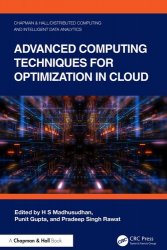Advanced Computing Techniques for Optimization in Cloud
- Добавил: literator
- Дата: 23-07-2024, 11:29
- Комментариев: 0
 Название: Advanced Computing Techniques for Optimization in Cloud
Название: Advanced Computing Techniques for Optimization in CloudАвтор: H S Madhusudhan, Punit Gupta, Pradeep Singh Rawat
Издательство: CRC Press
Год: 2025
Страниц: 263
Язык: английский
Формат: pdf (true)
Размер: 22.1 MB
This book focuses on the current trends in research and analysis of virtual machine placement in a cloud data center. It discusses the integration of Machine Learning models and metaheuristic approaches for placement techniques. Taking into consideration the challenges of energy-efficient resource management in cloud data centers, it emphasizes upon computing resources being suitably utilised to serve application workloads in order to reduce energy utilisation, while maintaining apt performance. This book provides information on fault-tolerant mechanisms in the cloud and provides an outlook on task scheduling techniques.
· Focuses on virtual machine placement and migration techniques for cloud data centers
· Presents the role of Machine Learning and metaheuristic approaches for optimisation in cloud computing services
· Includes application of placement techniques for quality of service, performance, and reliability improvement
· Explores data center resource management, load balancing and orchestration using machine learning techniques
· Analyses dynamic and scalable resource scheduling with a focus on resource management
Nature-inspired algorithms offer versatile solutions to key challenges in cloud computing. Workload prediction and optimization benefit from algorithms like genetic algorithms (GAs), particle swarm optimization, and ant colony optimization, which replicate natural selection, swarm behavior, and collective intelligence. These algorithms analyze historical patterns and forecast future demand shifts, enabling resource allocation adjustments that prevent inefficiencies. They also contribute to fair multi-tenant environments by drawing on predator–prey dynamics to distribute resources equitably. Cost optimization thrives through algorithms like simulated annealing, mirroring cooling metal’s energy reduction process to finely balance performance and cost. These algorithms also fortify security and compliance, with immune system-inspired mechanisms enhancing resource isolation and data protection.
Interoperability rests on standardized protocols, APIs, and frameworks that enable consistent communication and interaction between disparate cloud systems. These mechanisms ensure that data can be easily migrated or shared between different platforms without compromising integrity or performance:
• Kubernetes: Kubernetes, an open-source container orchestration platform, serves as a prime example of achieving interoperability between different cloud platforms. Kubernetes’ standardized APIs and portable manifest files, describing application configurations, enable effortless migration. The platform’s inherent load balancing, scaling, and auto-recovery capabilities ensure consistent behavior, regardless of the underlying cloud infrastructure. Kubernetes’ flexibility in choosing cloud-native services or custom components fosters a harmonious coexistence of services from different providers. By embracing Kubernetes, the retail business harnesses the benefits of interoperability: agility, reduced vendor lock-in, and the ability to leverage the strengths of various cloud platforms while maintaining a coherent application experience.
• OpenStack: OpenStack’s APIs and comprehensive set of services ensure that resources are allocated, orchestrated, and monitored consistently, regardless of the underlying infrastructure. The institution can provision virtual machines, storage, and networking resources with uniformity, thereby avoiding fragmentation and inefficiencies.
Both Kubernetes and OpenStack exemplify the significance of interoperability in cloud computing. By standardizing interfaces, abstracting complexities, and providing consistent management frameworks, these platforms empower organizations to seamlessly navigate diverse cloud environments, thereby enhancing flexibility, scalability, and resource utilization while mitigating the challenges posed by heterogeneous infrastructures.
The text is for postgraduate students, professionals, and academic researchers working in the fields of Computer Science and information technology.
Скачать Advanced Computing Techniques for Optimization in Cloud
Внимание
Уважаемый посетитель, Вы зашли на сайт как незарегистрированный пользователь.
Мы рекомендуем Вам зарегистрироваться либо войти на сайт под своим именем.
Уважаемый посетитель, Вы зашли на сайт как незарегистрированный пользователь.
Мы рекомендуем Вам зарегистрироваться либо войти на сайт под своим именем.
Информация
Посетители, находящиеся в группе Гости, не могут оставлять комментарии к данной публикации.
Посетители, находящиеся в группе Гости, не могут оставлять комментарии к данной публикации.
